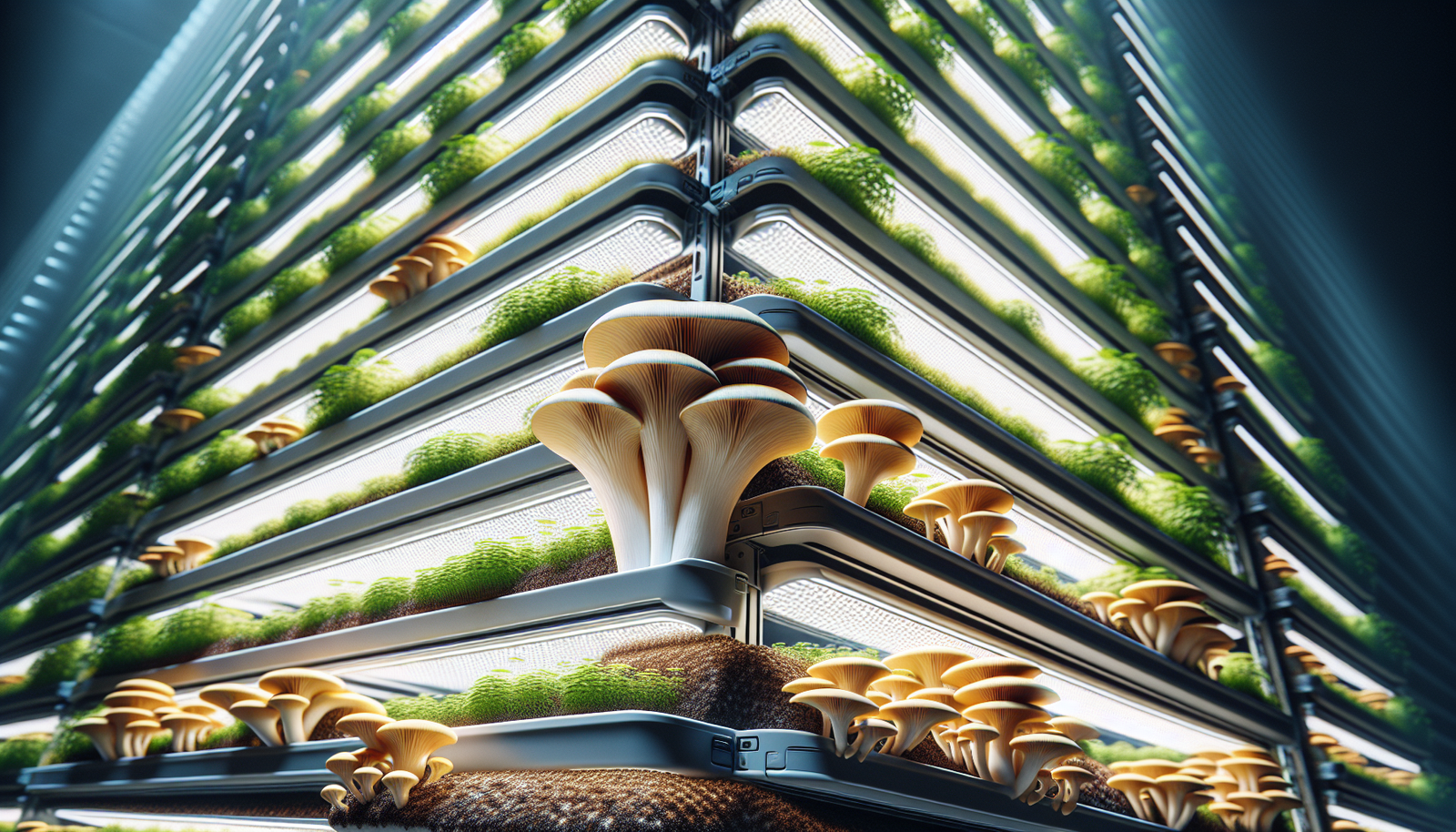
Imagine a future where fresh, nutrient-rich mushrooms are grown right in the heart of our cities, without the need for vast expanses of fertile land. This tantalizing vision is made possible by the cutting-edge concept of vertical farming, where crops are cultivated on multiple stacked levels within specially designed buildings. While this method has already proven successful for various crops, the particular potential of vertical farming with mushrooms is starting to garner attention. Not only does it offer a sustainable solution for increasing food production, but it also presents exciting possibilities for urban areas to become self-sufficient in cultivating this earthy delicacy. In this article, we will explore the transformative potential of vertical farming with mushrooms and its implications for the future of agriculture.
Benefits of Vertical Farming
Maximizing Space Utilization
Vertical farming is a revolutionary approach to agriculture that aims to maximize space utilization. By growing crops vertically in stacked layers, farmers can utilize the available space more efficiently. Unlike traditional farming, where crops are spread out horizontally in large fields, vertical farming allows for the cultivation of plants in a vertical space, making it the perfect solution for urban areas with limited land.
Reduced Water Usage
Another significant benefit of vertical farming is the reduced water usage. Traditional farming methods often rely heavily on water irrigation, which can lead to significant water waste. In vertical farming, water is recirculated and reused, significantly reducing the overall water consumption. This is possible due to advanced hydroponic and aeroponic systems that deliver water directly to the roots of the plants, minimizing evaporation and runoff.
Eliminating the Need for Pesticides
Vertical farming offers the opportunity to eliminate the need for pesticides. In traditional farming, pests and diseases can cause significant damage to crops, leading to yield loss and environmental pollution due to pesticide usage. However, in a controlled vertical farming environment, pests can be effectively managed through integrated pest management techniques and non-toxic methods such as biological controls. This eliminates the need for harmful chemical pesticides, making vertical farming a more sustainable and environmentally friendly option.
Year-Round Crop Production
Vertical farming ensures year-round crop production, regardless of the season or external climate conditions. By providing the ideal growing environment, including controlled temperature, light, and humidity levels, farmers can grow crops continuously without being restricted to specific seasons. This consistent production allows for a reliable and steady supply of fresh produce, reducing dependence on seasonal imports and ensuring food security.
Reduced Transportation Costs
With vertical farming, there is a significant reduction in transportation costs. Traditional farming often requires long journeys from rural areas to urban centers where most consumers are located. This transportation process not only incurs costs but also contributes to carbon emissions and environmental pollution. Vertical farms, on the other hand, can be established in or near urban areas, minimizing travel distances and reducing the need for transportation. This results in lower carbon footprints and ultimately benefits both the environment and the consumer.
Overview of Vertical Farming Techniques
Hydroponics
Hydroponics is a popular technique used in vertical farming, where plants are grown in nutrient-rich water without soil. This soil-less method allows for precise control over the nutrient composition and pH levels, ensuring optimal plant growth. Hydroponics also uses less water compared to traditional soil-based farming, making it a more efficient and sustainable option.
Aeroponics
Aeroponics is another technique utilized in vertical farming, where plants are grown in a mist or aerosol environment. The plant’s roots are suspended in the air, and a nutrient-rich mist is periodically sprayed onto them. This method promotes faster growth and greater oxygenation of the roots, leading to healthier and more productive plants. Aeroponics is also water-efficient and can significantly reduce water usage compared to other farming methods.
Aquaponics
Aquaponics combines hydroponics with fish farming, creating a symbiotic ecosystem. In aquaponic systems, fish waste provides nutrients to the plants, while the plants filter the water for the fish. This mutually beneficial relationship allows for sustainable and efficient nutrient cycling, reducing the need for additional fertilizers. Aquaponics is a closed-loop system that minimizes waste and maximizes resource utilization, making it an environmentally-friendly farming technique.
Smart Lighting and Environmental Controls
Vertical farming relies heavily on advanced technologies such as smart lighting and environmental controls. By utilizing artificial lighting systems, farmers can provide the optimal light spectrum and intensity for plant growth, regardless of the external weather conditions or daylight availability. Environmental controls, including temperature and humidity regulation, ensure the ideal growing environment for plants. These technologies enable farmers to customize and optimize the conditions for each crop, resulting in higher yields and superior quality produce.
The Potential of Mushroom Cultivation
Nutritional Value of Mushrooms
Mushrooms are not only delicious but also highly nutritious. They are low in calories and fat and contain essential nutrients such as vitamins, minerals, and dietary fiber. Mushrooms are particularly rich in potassium, vitamin D, and B vitamins, making them a valuable addition to a healthy diet. The unique nutritional profile of mushrooms makes them a sought-after ingredient, especially for those seeking nutritious and flavorful plant-based alternatives.
Growing Demand for Mushrooms
There is a growing demand for mushrooms worldwide, driven by various factors. Firstly, mushrooms are increasingly recognized as a healthy and versatile ingredient, gaining popularity in both traditional and modern cuisine. Additionally, the rise of vegetarian and vegan lifestyles has led to an increased demand for plant-based protein sources, with mushrooms being a favored choice. Lastly, the interest in natural and functional foods has also contributed to the surge in mushroom consumption due to their potential health benefits.
Medicinal Properties of Mushrooms
Mushrooms have been valued for their medicinal properties for centuries. Certain species of mushrooms, such as the reishi, lion’s mane, and shiitake, are known to possess bioactive compounds that have potential health benefits. These compounds, including polysaccharides and triterpenes, have been studied for their anti-inflammatory, antimicrobial, immune-boosting, and even anti-cancer properties. The integration of mushrooms in vertical farming allows for a controlled and optimized production of these medicinal mushrooms, providing a sustainable and reliable source of natural remedies.
Integration of Mushrooms in Vertical Farming
Compatibility with Controlled Environment Agriculture (CEA)
Mushroom cultivation is highly compatible with controlled environment agriculture (CEA), the foundation of vertical farming. Both mushrooms and other crops grown in vertical farms require precise control over temperature, humidity, and lighting conditions. By integrating mushrooms into multi-tiered vertical farming systems, farmers can maximize space utilization and optimize environmental controls to accommodate the specific requirements of mushroom cultivation.
Suitable Growth Conditions for Mushroom Cultivation
Mushrooms have unique growth requirements, including specific temperature, humidity, and light conditions. Vertical farming offers the flexibility to create and maintain the optimal environment for mushroom growth. This includes controlling the ambient temperature, humidity levels, air circulation, and light exposure, ensuring the mushrooms receive the ideal conditions to thrive.
Integration into Multi-Tiered Vertical Farming Systems
Mushrooms can be effectively integrated into multi-tiered vertical farming systems. By utilizing the vertical space, mushrooms can be cultivated on shelves or racks, optimizing the use of available space. This integration allows farmers to diversify their crops and maximize their yield within the same footprint, making vertical farms even more economically and environmentally viable.
Challenges and Solutions
Mushroom-Specific Growing Requirements
Cultivating mushrooms in vertical farms presents specific challenges due to their unique growth requirements. Achieving the right temperature and humidity levels, providing adequate air circulation, and ensuring proper lighting can be demanding. However, innovative climate control systems, such as smart sensors and automated controls, can accurately monitor and adjust the growing conditions to meet the specific needs of mushroom cultivation.
Contamination Risks and Disease Management
Mushrooms are susceptible to contamination and diseases, which can impact crop yield and quality. Implementing strict hygiene measures, maintaining sterile conditions, and using high-quality substrates can help minimize contamination risks. Additionally, integrated pest management techniques can be employed to prevent and control pests without relying on chemical pesticides, further ensuring the health and safety of the mushroom crops.
Optimal Harvesting Techniques
Harvesting mushrooms at the right time is crucial for quality and yield. Different mushroom varieties have specific harvesting requirements, and improper harvesting techniques can damage the delicate fruiting bodies. Training farm workers in proper harvesting methods and utilizing automation technologies, such as automated pickers, can ensure efficient and precise harvesting, improving productivity and reducing the risk of post-harvest losses.
Scaling up Production
Scaling up mushroom production in vertical farms requires careful planning and implementation. As the demand for mushrooms grows, vertical farms need to expand their capacity while maintaining consistent quality and yield. This can be achieved by optimizing production processes, investing in automation and robotics, and diversifying mushroom varieties to cater to different market demands. Collaboration with agricultural experts and researchers can also provide valuable insights for scaling up production efficiently and sustainably.
Innovations in Mushroom Vertical Farming
Automated Growing Systems
Automation plays a pivotal role in the advancement of mushroom vertical farming. Automated growing systems can monitor and control environmental conditions, nutrient delivery, and harvesting, reducing human labor and improving overall productivity. These systems utilize sensors, actuators, and artificial intelligence to optimize the growing process, resulting in higher yields, faster production cycles, and consistent quality.
Development of Specialized Substrates
Substrates, or the materials on which mushrooms grow, play a crucial role in cultivation. Innovative research and development efforts have led to the formulation of specialized substrates that enhance mushroom growth and yield. These substrates can be tailored to specific mushroom species, offering optimal nutrition and physical support for their development. The use of sustainable and locally sourced substrates further contributes to the environmental sustainability of mushroom vertical farming.
Inoculation and Spawn Production Advancements
Inoculation, the process of introducing mushroom spawn (mycelium) into a substrate, is a critical step in mushroom cultivation. Advances in inoculation technology have improved efficiency and ensured consistent spawn quality. Automated and sterile inoculation systems streamline the process, reducing human error and contamination risks. Additionally, spawn production techniques have been refined, allowing for large-scale production of high-quality spawn, enabling the continuous expansion of mushroom vertical farming operations.
Environmental Benefits of Mushroom Vertical Farming
Reduced Carbon Footprint
Mushroom vertical farming offers significant environmental benefits, including a reduced carbon footprint. By eliminating the need for long-distance transportation and optimizing resource utilization, such as water and energy, mushroom farming in vertical systems can greatly minimize greenhouse gas emissions. Additionally, the use of sustainable substrates, waste recycling, and the potential for carbon capture through mushroom mycelium further contribute to the environmental sustainability of this farming method.
Waste Conversion and Recycling
Mushroom vertical farming has the potential to convert various organic waste materials into valuable resources. Mushroom mycelium is highly effective in decomposing and breaking down organic matter, including agricultural waste, food scraps, and even certain types of plastics. This waste-to-resource conversion not only reduces waste accumulation but also produces nutrient-rich compost and bioactive compounds from the decomposed materials, further enriching the substrate used for mushroom cultivation.
Water Conservation
Vertical farming, including mushroom cultivation, is inherently water-efficient. The closed-loop irrigation systems and recirculating water used in vertical farms significantly reduce water consumption compared to traditional farming methods. Additionally, specific mushroom varieties, such as oyster mushrooms, have low water requirements, making them well-suited for vertical farming systems. The conservation of water resources through mushroom vertical farming contributes to the sustainability and resilience of agriculture.
Economic Viability and Future Potential
Cost-Effectiveness of Vertical Mushroom Farming
Vertical mushroom farming can be economically viable due to several factors. The controlled environment and optimized growing conditions result in higher yields and reduced crop losses, ensuring a consistent and reliable supply of mushrooms. Furthermore, the use of automation and advanced technologies can streamline production processes and reduce labor costs. The shorter supply chains and potential for local distribution can further enhance the economic viability of vertical mushroom farming, providing a competitive advantage in the market.
Market Demand and Profitability
The market demand for mushrooms continues to grow rapidly, driven by various factors such as increased consumer awareness of their nutritional value, culinary versatility, and potential health benefits. This growing demand creates a favorable market landscape for mushroom producers, enabling them to achieve profitability in vertical farming operations. With the ability to produce fresh and high-quality mushrooms consistently, vertical farms can cater to local markets, premium restaurants, and even specialized industries, such as the pharmaceutical and nutraceutical sectors.
Integration with Local Food Systems
Vertical mushroom farming has the potential to integrate seamlessly with local food systems, enhancing sustainability, and resilience. By establishing urban or peri-urban farms, mushrooms can be produced and distributed within the same community, reducing the reliance on long-distance transportation and reducing carbon emissions. The shorter supply chains also ensure fresher and more nutritious produce reaches the consumers, strengthening the local food economy and fostering a sense of food security.
Applications and Diversification
The Culinary Market
The culinary market is a significant driver of the demand for mushrooms. Mushrooms offer unique flavors and textures, making them a versatile ingredient in various cuisines worldwide. Vertical mushroom farming allows for the cultivation of different mushroom species, including both savory and gourmet varieties, catering to the diverse needs of chefs, restaurants, and home cooks. The availability of fresh and locally grown mushrooms ensures a sustainable and accessible supply for the culinary market.
Pharmaceutical and Nutraceutical Industry
Mushrooms have long been recognized for their potential health benefits and medicinal properties. The pharmaceutical and nutraceutical industries are increasingly turning to mushrooms for their bioactive compounds and therapeutic potential. Vertical mushroom farming provides a controlled and standardized environment for the production of medicinal mushrooms, ensuring consistent quality and potency. This integration opens up opportunities for collaboration between vertical farms and pharmaceutical companies, leading to the development of novel mushroom-based medicines and dietary supplements.
Cosmetics and Personal Care Products
Mushrooms also have applications in the cosmetics and personal care industry. Extracts from certain mushroom species, such as shiitake and reishi, are known for their rejuvenating and antioxidant properties, making them valuable ingredients in skincare and haircare products. Vertical mushroom farming allows for the sustainable production of these mushroom extracts, ensuring a reliable supply and contributing to the development of more environmentally friendly and natural cosmetic formulations.
Conclusion
Vertical farming with mushrooms offers a multitude of benefits and opportunities. By maximizing space utilization, reducing water usage, and eliminating the need for pesticides, vertical farming revolutionizes agriculture practices. The integration of mushrooms into vertical farming systems further enhances its potential by capitalizing on the nutritional value, growing demand, and unique properties of mushrooms. Despite the challenges, innovations in technology and production techniques are addressing these obstacles, making vertical mushroom farming increasingly efficient and sustainable. With its environmental benefits, economic viability, and diverse applications, vertical mushroom farming presents a promising future, shaping the agriculture and food industries for years to come.







